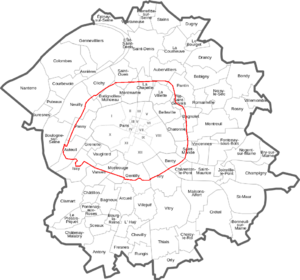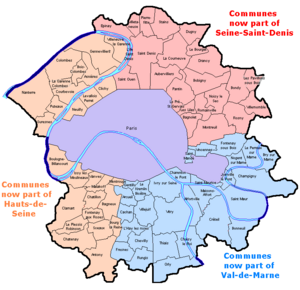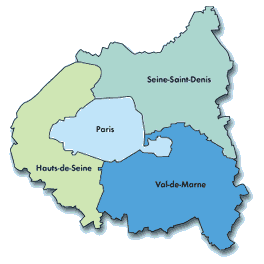Seine (department) facts for kids
The Seine was a special area, like a state or province, in France. It included the famous city of Paris and the towns right around it. It was unique because it was completely surrounded by another area called Seine-et-Oise. Paris was its main city and government center. The Seine department was officially ended in 1968. Its land was then divided into four new departments: Paris, Hauts-de-Seine, Seine-Saint-Denis, and Val-de-Marne.
Contents
What Was the Seine Department Like?
From 1929 until it was dissolved in 1968, the Seine department included the City of Paris and 80 towns nearby. It covered an area of about 480 square kilometers (185 square miles). Paris itself made up 22% of this area, and the surrounding towns made up the other 78%. It was the only area in France that was completely surrounded by another department. The Seine department was divided into three smaller administrative areas called arrondissements: Paris, Sceaux, and Saint-Denis.
For most of its history, the main official in charge of the Seine department, called the "prefect," also directly managed the City of Paris. This meant that Paris was the only town in France that didn't have its own elected mayor for a long time. It had less self-rule than even the smallest towns.
History of the Seine Department
How the Seine Department Started
The Seine department was created on March 4, 1790. It was first called the "Department of Paris." Later, in 1795, its name was changed to the "Department of Seine," named after the Seine River that flows through it.
In 1801, during the first official count of people in France, the Seine department had 631,585 residents. Most of them (87%) lived in Paris, and 13% lived in the suburbs. It was the second most populated department in the large French Empire at that time. Over the next 150 years, as Paris and its suburbs grew, the number of people living in the Seine department increased a lot.
Why the Seine Department Was Dissolved
By 1968, the Seine department had grown to have 5,700,754 residents. About 45% lived in Paris, and 55% lived in the suburbs. This made it the most populated department in France by far. People thought it had become too big to be managed well. So, on January 1, 1968, it was split into four smaller departments: Paris, Hauts-de-Seine, Seine-Saint-Denis, and Val-de-Marne. The last three also included parts of the old Seine-et-Oise department, which was also ended at the same time.
Here's how the Seine department was split:
- The city of Paris became its own department. It kept the official number 75, which was previously used for the Seine department.
- To the south and southeast of Paris, 29 towns from the Seine department joined with 18 towns from Seine-et-Oise. They formed the new Val-de-Marne department, given the number 94.
- To the west of Paris, 27 towns from the Seine department joined with nine towns from Seine-et-Oise. They formed the new Hauts-de-Seine department, given the number 92.
- Finally, to the north and northeast, the remaining 24 towns from the Seine department joined with 16 towns from Seine-et-Oise. They formed the new Seine-Saint-Denis department, given the number 93.
These three new departments—Hauts-de-Seine, Val-de-Marne, and Seine-Saint-Denis—are known in France as the Petite Couronne, which means "small ring." This is different from the Grande Couronne ("large ring"), which refers to the suburbs further away. The Petite Couronne plus the City of Paris together cover about 762 square kilometers, which is more than the old Seine department's 480 square kilometers.
In 2016, a new administrative area called the Métropole du Grand Paris was created. It includes Paris, the three departments of the Petite Couronne, and seven more towns from the Grande Couronne.
Population Changes Over Time
In 2006, the total population of the towns that used to be part of the Seine department was 5,496,468 people. The population of the department reached its highest point in 1968, with 5,700,754 residents. After that, the number of people living there went down until 1999, as many moved to suburbs further away from Paris. However, since 1999, the population has started to grow again, gaining 292,650 residents between 1999 and 2006. This new growth is similar to what has happened in the central areas of other big cities in the Western world, like Inner London.
Of the new departments created in 1968, Paris was the most populated in 2006, with 2,181,371 residents. The Paris department is currently the second most populated department in France, after the Nord department.
See also
 In Spanish: Sena (departamento) para niños
In Spanish: Sena (departamento) para niños





